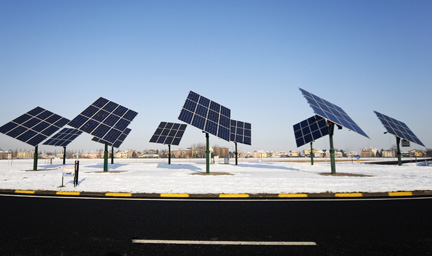
One of the earth’s most plentiful sources of renewable energy is being successfully paired with one of the most recyclable products.
Solar energy is being harnessed in conjunction with asphalt roadways producing favorable results. Ideology that was conceived in the mid-1990s has been implemented recently. The various concepts are gaining momentum, and the future has never looked brighter.
The two industries are being combined in various manners and degrees of magnitude. One of the most basic, yet effective, methods being used is the installation of solar panels along highway corridors.
The electricity generated from the panels is utilized to power lighting, road signs and tunnel fans. The state of Oregon lays claim to the first solar-powered highway in the United States. In December of 2008, a series of approximately 600 104kW solar panels were officially operational along the highway south of Portland.
This same methodology has been implemented in greater magnitude in Germany and Italy over the past few years. Italy’s roadside system of 80,000 solar panels gathers 12 million kilowatt hours per year, while Germany’s 16,000-panel system collects 3.2 million kilowatt hours per year.
At the University of Rhode Island, solar energy research has resulted in four possible techniques for implementation. The first method is to wrap flexible photovoltaic cells around highway medians and barriers, in order to gather the solar energy.
The second approach would be to install pipes filled with water below the surface of the roadway. The water heated in the piping could be used to warm buildings or to move turbines in power plants. The water could also be stored and returned to the roadway to potentially prevent or thaw icing.
The third technology is still in development, and involves connecting semiconductors placed at various depths in the pavement. The heat differential created across the semiconductors could be used to generate electricity, known as the Seebeck effect.
The final methodology is also the most futuristic. It entails the development of a multi-layered system consisting of a transparent surface and a complicated layer of electronics that are supported by a solar collecting sub-base. This complex roadway would have the ability to illuminate messages and would eliminate road markings and signs.
The development of solar-paneled roadways is an intriguing concept, but economically it seems overwhelming to consider. One Idaho-based company is continuing to develop this technology through the procurement of government funded grants.
The overall feasibility is being restricted to small areas such as sidewalks and parking lots, for the estimated cost to construct a driveway approaches $100,000.
Researchers at Worcester Polytechnic Institute in Massachusetts have focused their well-documented efforts on the installation of water-filled piping within the asphalt roadway. As reported at the International Society for Asphalt Pavements in Zurich, Switzerland (2008), they found that the warmest part of the pavement is located just centimeters from the surface.
Therefore, the heat exchangers would be installed in the wearing course to extract the heat from the pavement. They also found that using highly conductive aggregates, like quartzite, could further increase heat absorption. Their current plans are to replace the copper piping that carries the heated water with a highly efficient geotextile material as the heat exchanger.
A Dutch-based company with very similar technology is using an interlocking plastic grid to great success while implementing this system on several European roadways. As the water in the piping is heated, it is pumped deep under the ground to natural aquifers where it maintains a fairly constant temperature (68ºF). The heated water can be retrieved months later to heat the road surface to keep it free of snow and ice or transferred to help heat nearby buildings. From a separate reservoir, cool water could also be pumped to the roadway wearing course to cool the pavement temperature during summer extremes.
This solar technology has numerous benefits for the public and the environment. Harnessing the solar energy from asphalt roadways for further utilization is the biggest advantage. Potentially reducing rutting and oxidation of pavements is another benefit.
However, many questions arise. How will the roadway be milled and recycled with piping located in the wearing course? When the asphalt is worn away and the aggregate exposed, how will the lighter color affect solar absorption? Would the roadway need an occasional fog seal or sealcoat to repaint the surface black?
Solar energy is utilized in less than 0.05 percent of all global energy consumption today. In order to implement systems to capture the most plentiful renewable energy available, these solar innovations need to be researched and funded to further develop their efficiency. As the development and progression continue, asphalt roadways and solar energy should be able to work in tandem toward a brighter future.
Rory Klinger is the Director of the Liquid Asphalt Division at All States Material Group in Sunderland, Massachusetts.













